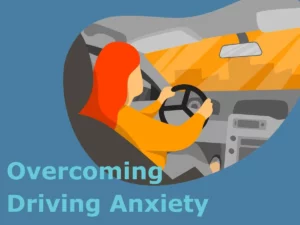Do you get anxious when you have to drive? You’re not alone. Driving anxiety is one of the most common phobias in the world. In this blog post, we will discuss what causes driving anxiety, and what you can do to overcome it. We’ll also provide some helpful tips for dealing with stressful driving situations. So if you’re ready to take control of your anxiety while on the wheel, keep reading!
Contents
Defining Driving Anxiety
 Driving can be intimidating and even scary for some people. For those who experience driving anxiety, the fear can be so severe that it interferes with their ability to drive. Driving anxiety is a type of specific phobia, which is an intense fear of a specific object or situation. People with driving anxiety have a preoccupation with the fear of losing control while driving, or being in a car accident. This fear can cause them to avoid driving altogether, or to feel very anxious and stressed when they do have to drive.
Driving can be intimidating and even scary for some people. For those who experience driving anxiety, the fear can be so severe that it interferes with their ability to drive. Driving anxiety is a type of specific phobia, which is an intense fear of a specific object or situation. People with driving anxiety have a preoccupation with the fear of losing control while driving, or being in a car accident. This fear can cause them to avoid driving altogether, or to feel very anxious and stressed when they do have to drive.
It is important to note that driving anxiety is different from road rage. Road rage is a form of aggressive driving that is characterized by angry and violent behavior. People with road rage may experience some of the same symptoms as people with driving anxiety, but they are not the same thing. Road rage is a choice while anxiety is an uncontrollable fear.
Signs And Symptoms
Since driving is a very overt activity, it is easy to see when someone is struggling with anxiety while driving. People who are anxious about driving may have physical symptoms such as sweating, shaking, or a racing heart. They may also feel dizzy or lightheaded. Mentally, they may feel like they are in a state of panic, and they may have difficulty concentrating on the task of driving.
In severe cases, people with driving anxiety may experience a full-blown panic attack while behind the wheel. This can be very dangerous, as it can make it difficult to maintain control of the vehicle.
A very notable thing when talking about the signs and symptoms of driving anxiety is avoidance. People with driving anxiety will often go to great lengths to avoid having to drive. This may mean taking longer routes that involve less driving, or avoiding highways and other busy roads. In some cases, people with driving anxiety will not leave their homes at all if they know they will have to drive.
Causes And Risk Factors
A fear or anxiety surrounding something as mundane as driving can have multiple causes. The most commonly cited cause of driving anxiety is previous traumatic events, such as a car accident. Even if the accident was not severe, or even if the person did not face any harm, the experience can be enough to trigger a phobia. Other causes of driving anxiety may include:
- Fear of losing control: Having a fear of losing control is one of the most common symptoms of driving anxiety. This can manifest itself in a number of ways, such as feeling like you can’t keep your car on the road, or feeling like you’re going to have an accident.
- Seeing other drivers make mistakes: This is a common trigger for driving anxiety. If you see another driver make a mistake, it can trigger your own anxiety and make you feel like you’re going to make a mistake as well.
- Making mistakes: Making mistakes while driving can also trigger anxiety. This can be anything from forgetting to turn your blinker on, to accidentally cutting someone off.
- Having improper guidance: Driving is relatively easy, but it needs to be done correctly in order to avoid accidents. If you don’t feel like you have proper guidance, it can cause anxiety.
- Witnessing accidents: Unfortunately, accidents are a part of driving. If you witness an accident, it can trigger your anxiety and make you feel like it’s going to happen to you.
These are just a few of the most common triggers of this type of anxiety. There are also certain risk factors that can increase your chances of developing driving anxiety. These include:
- Being a young driver: Young drivers are more likely to develop driving anxiety because they have less experience behind the wheel.
- Having other phobias: If you have other phobias, such as a fear of heights or a fear of enclosed spaces, you’re more likely to develop driving anxiety.
- Being female: It is a common stereotype that women have a tendency to be more anxious than men. While this isn’t always the case, it can be a factor in developing anxiety while driving.
One important thing to remember is that one can develop driving anxiety at any time. It doesn’t matter how long you’ve been driving, or how many miles you’ve driven. If you have a fear or anxiety surrounding driving, it is important to seek help.
Link With Other Disorders
 Driving anxiety is a very vague and broad spectrum that mainly implies feelings of nervousness or unease while driving. This spectrum can actually be a symptom for other disorders. It is important to understand that if you are feeling extreme anxiety while driving, it could be a sign of a more serious problem. Some of these disorders are:
Driving anxiety is a very vague and broad spectrum that mainly implies feelings of nervousness or unease while driving. This spectrum can actually be a symptom for other disorders. It is important to understand that if you are feeling extreme anxiety while driving, it could be a sign of a more serious problem. Some of these disorders are:
- Generalized Anxiety Disorder: This is one of the most common disorders that can be linked with driving anxiety. People with this disorder tend to worry excessively about many different things, including driving.
- Social Anxiety Disorder: This disorder is characterized by a fear of social situations. This can include driving, as it is a social situation. People with this disorder may avoid driving because they are afraid of facing judgements by other drivers.
- Panic Disorder: This disorder is characterized by panic attacks. These can be triggered by many different things, including driving. People with this disorder may avoid driving because they are afraid of having a panic attack while behind the wheel.
- Specific phobias: Phobia is a term that describes a fear of a specific thing. Venophobia is the particular phobia of driving. People with this disorder may have an irrational fear of driving and may avoid it at all costs.
- Depression: This disorder is characterized by feelings of sadness, emptiness, and hopelessness. People with depression may avoid driving because they don’t see the point in it.
- Obsessive-Compulsive Disorder: This disorder is characterized by obsessive thoughts and compulsions. People with this disorder may be obsessed with the idea of having an accident while driving. They may also have compulsions, such as needing to check and recheck their seatbelt or mirrors.
- Post-Traumatic Stress Disorder: This disorder is characterized by flashbacks and nightmares. People with this disorder may avoid driving because they are afraid of having a flashback or nightmare while behind the wheel.
If you are experiencing any of these symptoms, it is important to seek help from a mental health professional. Driving anxiety can be a symptom of a more serious problem, that can further cause problems if left untreated.
Consequences
Having anxiety around driving can have many consequences. The most common consequence is avoiding driving altogether. This can cause havoc and disruption in one’s life, as they may not be able to go to work, school, or run errands. Avoiding driving can also lead to feelings of isolation and loneliness. Another common consequence is feeling stressed and anxious while driving. This can lead to increased heart rate and blood pressure, sweating, shaking, and difficulty breathing. This can be very dangerous, as it can lead to accidents.
There are also some lesser talked about consequences of driving anxiety. When one doesn’t wish to drive, they may constantly look for someone else to drive them places. This can put a strain on relationships, as the person may feel like they are always asking for favors. If someone is frequently taking public transport or cabs, it can also be very costly. In some cases, people have sold their car or given it away because they can’t bring themselves to drive it. All these combined can lead to low quality of life.
The most vital thing to note is that driving anxiety is treatable. If you or someone you know is struggling with driving anxiety, there are steps that can be taken to overcome it.
Tips To Manage
 If driving anxiety is interfering with your life, there are treatment options available. The most common and effective treatment for specific phobias, like driving anxiety, is exposure therapy. This type of therapy involves gradually exposing the person to the thing they are afraid of, in this case, driving. The exposure can be happen in a safe and controlled environment, such as with a therapist or in a virtual reality simulator.
If driving anxiety is interfering with your life, there are treatment options available. The most common and effective treatment for specific phobias, like driving anxiety, is exposure therapy. This type of therapy involves gradually exposing the person to the thing they are afraid of, in this case, driving. The exposure can be happen in a safe and controlled environment, such as with a therapist or in a virtual reality simulator.
There are also other forms of professional intervention that can aid in the management of this type of anxiety. These include cognitive-behavioral therapy, which can help to change the way a person thinks about driving, and medication, which can help to reduce anxiety symptoms. If you are struggling with driving anxiety, it is important to seek professional help.
Moreover, there are also some great self-help strategies that can provide relief.
- One of the most important things you can do is to educate yourself about driving anxiety and how it works. This can help to dispel any myths or misconceptions that you may have about the disorder.
- It can also be helpful to practice relaxation techniques, such as deep breathing or progressive muscle relaxation. These techniques can help to reduce the physical symptoms of anxiety. You can also repeat positive affirmations to yourself, such as “I can do this” or “I am a good driver.”
- Some people also report that driving with the windows open or listening to calming music can help to ease anxiety while driving.
- Whenever possible, it is also important to try and drive in daylight and in good weather conditions. This can help to make the experience less daunting.
- If you know you will encounter a situation that makes you anxious while driving, it can be helpful to plan ahead. This may involve taking a different route or leaving earlier so that you don’t have to rush.
- Start by taking short drives to familiar places, and gradually work up to longer drives. It is also important to be prepared before driving, by mapping out your route and planning for rest stops.
- Keeping some comforting items in the car, such as a favorite blanket or toy, can also be helpful. These can provide a sense of safety and security.
- Finally, it is also important to build a support system of friends or family members who can offer understanding and assistance.
Making these small changes can help to make a big difference in your driving anxiety. If you are struggling with anxiety on the road, know that you are not alone. This disorder is very common and there are many resources available to help you overcome it. With the right treatment, driving anxiety can become manageable so that it no longer interferes with your life.
Conclusion
To conclude, we say that driving anxiety is a very real and serious problem that can have a significant impact on one’s life. However, it is important to remember that this condition is treatable. If you or someone you know is struggling, there are ways and techniques to overcome it.
If you or someone you know is looking for psychological help, Therapy Mantra is here for you. We are the leading providers of online therapy and counseling. Our team of highly trained and experienced therapists can provide assistance at the most affordable rates. Contact us today to learn more about our services. You may also visit our website to book an online therapy session or download our free Android or iOS app for more information.


